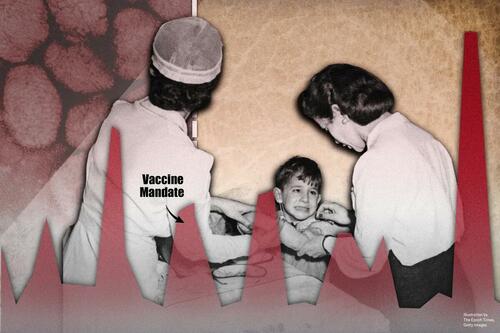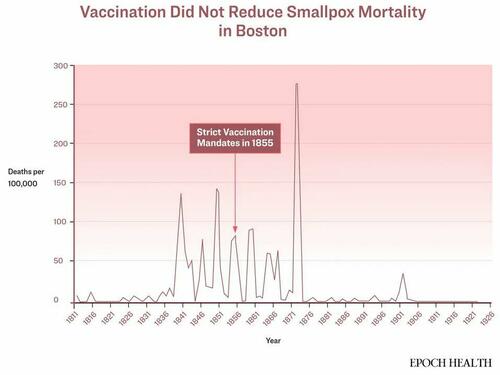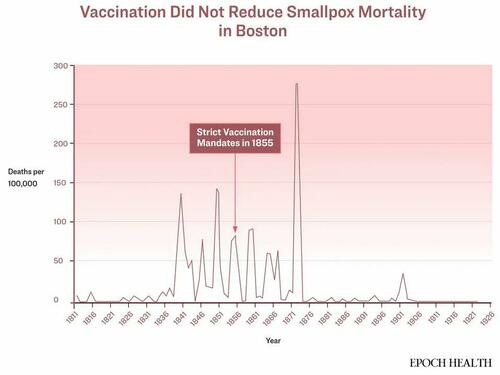Did The Vaccine Eradicate Smallpox?
Authored by Yuhong Dong via The Epoch Times (emphasis ours),
The widespread faith in vaccines is often traced back to the assumption that the first vaccine in human history effectively eradicated one of the deadliest pandemics. However, does this belief hold true?
Despite the unclear nature of the original smallpox vaccine invented by Dr. Jenner and its increasing failures and medical challenges, there remains an underlying societal belief that smallpox vaccines effectively prevent smallpox. By the year 1801, an estimated 100,000 people were vaccinated for smallpox in England.
In the 1970s, a smallpox global eradication effort led by a World Health Organization (WHO) officer and American medical doctor, Dr. Donald Ainslie Henderson (1928 to 2016), initially used a strategy of mass vaccination campaigns to achieve 80 percent vaccine coverage in each country.
The campaign integrated mass vaccination programs, surveillance of outbreaks, and rapid response to any reported cases. By 1977, the last natural case of smallpox was recorded in Somalia, leading to the WHO’s declaration of smallpox eradication in 1980.
Yet this begs the question: Is there any direct evidence that the infection or mortality rate has declined due to vaccination?
In search of evidence that smallpox vaccination plays a direct role in eradicating the smallpox waves, we found quite a few examples showing that the waves of smallpox seen throughout history were even more severe after a massive vaccination program.
US: No Decline After Vaccination
Dr. Suzanne Humphries, an internist and board-certified nephrologist has practiced medicine in conventional hospital settings for over 20 years. The graphs below represent some key facts from her book about smallpox, “Dissolving Illusions.”
She spent countless hours at Yale’s medical library and other libraries scouring medical journals, books, and newspapers to locate mortality data and create computerized graphs.
Records from Boston, starting in 1811, reveal recurring smallpox epidemics beginning around 1837. Despite the introduction of vaccination mandates in 1855, epidemics continued to occur in 1859 to 1860, 1864 to 1865, and 1867, with a particularly severe outbreak from 1872 to 1873. The continual reoccurrence of these epidemics in Massachusetts indicates that stringent vaccination regulations had no positive impact on curbing smallpox.
According to the research article, “SmallPox and Revaccination,” published in the 1881 Boston Medical and Surgical Journal, “The latest epidemic that of 1872–1873, having proved fatal to 1,040 persons, was the most severe that has been experienced in Boston since the introduction of vaccination.”
In Chicago, despite 95 percent vaccination coverage by 1868 and mandatory vaccination after the Great Chicago Fire of 1871, a severe smallpox epidemic occurred in 1872. Over 2,000 people contracted smallpox, and more than a quarter of these died, with the highest fatality rate among children under age 5.
Europe: No Decline After Vaccination
Throughout the Western world, epidemics were more severe in highly-vaccinated populations.
Dr. G. W. Harman published an article in the 1900 medical journal Medical Brief entitled “A Physician’s Argument Against the Efficacy of Virus Inoculation,” highlighting widespread smallpox cases among vaccinated individuals in England, France, and Germany.
England
In England, the smallpox vaccination became compulsory in 1853.
Yet since then, there have been three smallpox epidemics. The first occurred from 1857 to 1859, with 14,244 death cases; the second happened from 1863 to 1865, with 20,059 deaths; the third wave, from 1870 to 1872, had 40,840 deaths. The population increased from the first to the second epidemic by 7 percent, yet the increase in smallpox cases was nearly 50 percent. The population increased by 10 percent from the second to the third epidemic, yet smallpox cases increased by 120 percent.
Dr. Harman cited data published on July 15, 1871, from The London Lancet reporting that of the 9,392 smallpox patients in London hospitals, 6,854 had been vaccinated (73 percent) and 17.5 percent of vaccinated patients died.
The death rate for smallpox declined after 1872, but there is no evidence that vaccination had anything to do with it. In the early 1900s, death from smallpox all but vanished from England.
France
During the Franco-Prussian War from July 1870 to January 1871, the French army had 23,469 smallpox cases and every army recruit was required to be vaccinated.
Dr. Charles Creighton’s 1888 critical review in the Encyclopedia Britannica highlighted a mortality rate from smallpox in Prussia of 60,000 deaths between 1870 and 1873, despite widespread vaccination. “Not withstanding the fact that Prussia was the best revaccinated country in Europe, its mortality from smallpox in the epidemic of 1871 was higher (59,839) than in any other northern state,” he wrote.
Germany
In Bavaria, Germany in 1871, nearly 96 percent of all smallpox cases occurred in vaccinated individuals (29,429 of 30,742).
Between 1870 and 1885, official records indicated that 1 million vaccinated individuals died from smallpox.
Italy
In 1888, despite a population in Italy that was extensively vaccinated and revaccinated, smallpox wreaked havoc in numerous towns. Many of these towns had adhered to a biannual vaccination regimen for several years.
In 1899, Dr. Ruata documented the failure of vaccination in Italy. Numerous smallpox outbreaks resulted in 18,110 deaths, including the following notable instances:
- Badolato recorded 1,200 smallpox cases (population 3,800).
- Guardavalle had 2,300 cases (population 3,500).
- St. Caterina del Jonio had 1,200 cases (population 2,700).
- Sortino documented 570 deaths (population 9,000).
- San Cono had 135 deaths (population 1,600).
- Vittoria reported a staggering 2,100 deaths (population 2,600).
Dr. Ruata wrote: “Can you cite anything worse before the invention of vaccination? And, the population of these villages is perfectly vaccinated, as I have proved already, not only, but I obtained from the local authorities a declaration that vaccination has been performed twice a year in the most satisfactory manner for many years past.”
Japan: No Decline After Vaccination
Dr. Simon Katzoff reported that compulsory vaccination laws began in Japan in 1872, and stricter revaccination mandates were passed in 1885. Laws required infants to be vaccinated and revaccinated up to three times within their first year if the first attempt was unsuccessful, then every year after that for seven years.
However, these measures didn’t prevent outbreaks. Smallpox remained rampant.
Between 1885 and 1892, with over 25 million vaccinations and revaccinations, there were still 156,175 smallpox cases and 39,979 deaths. From 1892 to 1897, Japan recorded 142,032 smallpox cases and 39,536 deaths.
Even after an 1896 law mandating vaccination every five years for everyone, the country saw 41,946 cases and 12,276 deaths in 1897 alone—a 32 percent mortality rate—almost double the rate before the vaccination era.
Smallpox Waves Fluctuate, Independent of Vaccinations
Based on the smallpox waves noted above, the virus appears to independently fluctuate, regardless of vaccination.
For instance, in the 1700s, London witnessed a substantial decline in smallpox deaths, even before the widespread use of vaccination. In the 18th century, several outbreaks occurred, despite vaccination mandates.
Read more here…
Tyler Durden
Mon, 01/08/2024 – 03:30
via ZeroHedge News https://ift.tt/I102dmy Tyler Durden




